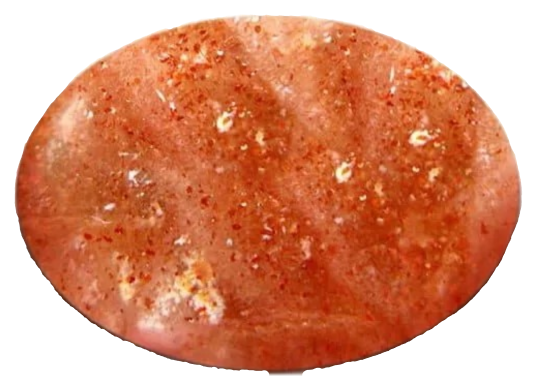
Sunstone, an extraordinary gemstone that glows with vibrant hues, has captivated humankind for centuries with its unique beauty and mystical allure. Named for its radiant appearance, Sunstone is cherished not only as a decorative gem but also for its symbolic and metaphysical properties. This comprehensive guide explores the fascinating origins, characteristics, historical significance, and spiritual meanings of Sunstone.
Origins of Its Name and Alternate Names
The name “Sunstone” is derived from its resemblance to the radiant warmth and colour of the sun. Its glimmering appearance, often reflecting golden or orange hues, gives the impression of sunlight captured within the stone.
In ancient times, Sunstone was referred to as “Heliolite,” a name derived from the Greek words helios (sun) and lithos (stone). It is also sometimes called the “Stone of Leadership” in metaphysical circles, symbolising confidence and vitality.
Composition and Physical Characteristics
Sunstone is a variety of feldspar, primarily composed of sodium aluminium silicate. Its distinctive shimmer, known as aventurescence, is caused by the presence of tiny plate-like inclusions of hematite or goethite. These inclusions reflect light to create a glittering effect that adds to its enchanting appearance.
Physical Characteristics and Varieties
- Appearance: Typically ranges in colour from pale peach and gold to deep orange and reddish-brown. High-quality stones exhibit a strong aventurescence.
- Hardness: Measures 6 to 6.5 on the Mohs scale, making it suitable for jewellery and ornamentation.
- Transparency: Can range from translucent to opaque.
Varieties include:
- Oregon Sunstone: Known for its vibrant colours and aventurescence.
- Indian Sunstone: Often has a softer shimmer with subtler colours.
- Norwegian Sunstone: Historically significant, found in Viking navigational tools.
Geographical Locations
Sunstone is found in several regions across the globe, each offering unique specimens:
- United States: Particularly in Oregon, where high-quality Sunstone is mined.
- India: Known for producing commercial-grade Sunstone used in jewellery.
- Norway: Viking-era deposits have historical significance.
- Russia: Found in regions near Siberia.
- Australia: Known for deposits in South Australia and Tasmania.
Historical Usage and Archaeological Finds
Sunstone has been valued since ancient times, with many cultures attributing symbolic meanings to its radiant glow. Viking explorers are believed to have used Sunstone as a navigational tool, leveraging its reflective properties to locate the sun on cloudy days. Archaeological discoveries of polished Sunstone fragments in Viking settlements support this theory.
In other cultures, Sunstone was revered as a talisman of good fortune, health, and abundance. It was often used in rituals and ceremonies to invoke the power of the sun and inspire vitality.
Interesting Facts
- Sunstone’s aventurescence is often mistaken for metallic shimmer, but it is caused by light reflecting off tiny inclusions within the stone.
- Oregon Sunstone, the state gem of Oregon, is unique for containing copper, which enhances its sparkle.
- Viking legends describe Sunstone as a “solar stone,” helping navigators find their way across the seas.
Folklore, Superstition, Legends, and Tales
Sunstone has been steeped in folklore and myth throughout history. In Norse mythology, Sunstone was believed to embody the power of the sun god and was considered a symbol of divine light and protection. Viking warriors carried Sunstone as a talisman to ensure victory and safe passage.
In Native American cultures, Sunstone was revered as a stone of the sun, believed to bring warmth, strength, and happiness to those who possessed it. Legends told of Sunstone falling from the sky, infused with the life force of the sun itself.
In metaphysical traditions, Sunstone is seen as a stone of joy and abundance. It is said to dispel darkness and negativity, replacing them with optimism and vitality. As a result, it is often used in rituals to manifest positivity and personal empowerment.
Mystical Healing Properties
Sunstone is widely celebrated for its energising and uplifting qualities:
- Emotional Healing: Promotes self-confidence, joy, and emotional resilience.
- Physical Healing: Thought to boost metabolism and support vitality.
- Spiritual Healing: Encourages alignment with higher energies and fosters a sense of purpose.
Astrological Links and the Chakra System
Sunstone is associated with the Sacral Chakra, enhancing creativity, passion, and emotional warmth. It is also linked to the Solar Plexus Chakra, which governs personal power and confidence.
Astrologically, Sunstone resonates with Leo for its fiery energy and self-assurance. It also aligns with Libra, fostering harmony and balance.
Use as a Birthstone and Wedding Anniversary Gift
While not officially recognised as a traditional birthstone, Sunstone is often chosen as a symbolic stone for those born under the zodiac signs Leo and Libra.
As a wedding anniversary gift, Sunstone represents vitality and joy, making it a meaningful choice for couples celebrating milestones filled with happiness and shared success.
Sunstone’s warm glow, fascinating history, and powerful symbolism make it a cherished gem for both aesthetic and spiritual purposes. Whether worn as jewellery, displayed as décor, or used in meditation, it embodies the radiant energy of the sun and the limitless potential within us all.

Sunstone
Sunstone radiates warmth, joy, and confidence. A stone of vitality and empowerment, it sparks creativity, lifts the spirit, and ignites personal strength.
